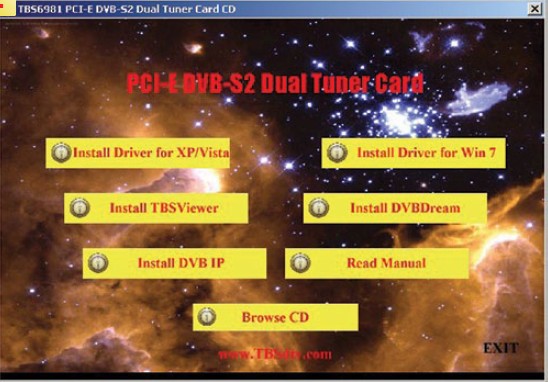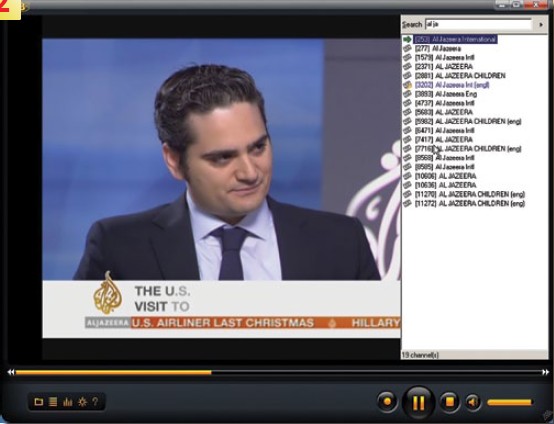DVB-S/S2 tuner card are gaining in popularity all the time, but at the same people are crazy about the PVR function of many conventional satellite receivers as well. After all, nothing beats the possibility of recording one event while at the same time watching another one. Is there a way to achieve this benefit with a PC card?
If you have a PVR receiver and are able to record one channel and watch a different one simultaneously then you need a box with two tuners and two IF inputs. When it comes to PC cards, this is very rare and that‘s why Tenow happily fills that gap with its new TBS6981.
The Tenow PCI-E is DVB-S and DVB-S2 compatible and hence features two DVB-S/S2 satellite inputs for both SDTV and HDTV. Apart from the TBS 6981 PC card (suitable for PCI-E slots version 1.0a and 1.1) you get an infrared receiver, a remote control, a software CD and a power cable to connect the card to the corresponding IDE power supply of the PC‘s power supply unit. In most cases the power supplied by the PCI-E slot will be sufficient, but if a DiSEqC motor is connected or other cards draw power as well, this auxiliary power connector will come in quite handy.
Installing the card does not require an engineering degree and thanks to its compact size it will even fit into devices with restricted space. Once the two tuner inputs are connected to the signal input cables all you need to do is connect the IR receiver to the socket next to the IF inputs to get started.
1. Right after inserting the CD its content is presented in a pleasing design
The remote control that comes with the card sits nicely in your hand and allows controlling the TBS 6981 without having to get up from your lounge room sofa. The manual is available on the mini CD in PDF format.
Tenow lists the following specifications for DVB-S reception: Intel Pentium III 1 GHz with 256MB RAM and a graphics cards with 16MB RAM. If you‘re after DVB-S2 signals you need to make sure to provide at least an Intel Pentium IV 3 GHz processor with 1GB RAM and a graphics card with a minimum of 64MB RAM. Tenow made the card compatible to the Windows XP, Windows Vista, Windows 7 and even Linux operating systems – the latter even for the latest Linux kernel.
Now that we had installed the card in our test PC and connected all required cables we proceeded with driver installation. Shortly after the CD is inserted an autostart wizard opens up on screen with all available options. A single mouse click is all it takes to start driver installation and a short while later Windows displays a message stating that new hardware was detected and is ready for use.
For all the Linux enthusiasts out there: Tenow even provided Linux drivers and made the card fully compatible to the latest Linux kernel.
2. Clearly arranged channel list of the TBSViewer
On the software front Tenow supplies its own TBSViewer presentation application,
but also offers the DVB Dream software on the CD as an alternative. We should not fail to mention at this stage that the card worked flawlessly with the hugely popular ProgDVB application as well and the manufacturer provides all necessary configuration files on the included CD. Windows Media Center (as included with Windows 7, for example) is supported, too.
It‘s basically up to the end user which software is paired to the Tenow card, and this is one of the major benefits of PC card solutions as opposed to set-top boxes, which – in most cases – can only be used with a single manufacturer-supplied firmware. For the purpose of this test report, however, we decided to stick to the software shipped by Tenow. In our
case the TBSViewer came with a prestored channel list of ASTRA 19.2° East, HOTBIRD 13° East, ASTRA3 23.5° East and ASTRA2 28.2° East which meant we were ready to party right away.
The OSD can be displayed in the following languages: English, German, French, Czech, Hungarian, Italian, Polish, Portuguese, Russian, Finnish and Ukrainian. A list of 176 European, Asian and American satellite positions complete with their transponder data is available, even though this information is not completely up-to-date.
All LOF parameters can be set manually, so that the PC card will work with all available LNBs. If your reception system includes a DiSEqC 1.0 switch for reception of up to four satellites you will be happy to find out that the Tenow card will nicely deal with this setup.
Surprisingly, the Tenow TBS 6981 even works smoothly with the SCR single cable solution, which is supported. The 22 kHz signal to switch between the upper and lower frequency band and the supply voltage for the LNB (13V for vertical/left circular signals and 18V for horizontal/right circular signals) work as expected and required.
3. Favourites list for finding your preferred channels with a single mouse click
Tenow offers three search modes: Automatic search looks for all transponders on the pre-stored list, manual search can be used to scan a single transponder which will then be locked.
We were impressed with the search speed of the TBS 6981, which only took three and a half minutes to scan 1.734 TV and radio channels on HOTBIRD at 13° East. Every search can be restricted to free-to-air channels only, which is particularly helpful as the PC card does not come with a CI slot for pay TV reception.
You might wonder now what the third search mode is, since we have only mentioned automatic and manual so far. It‘s a kind of blind scan mode and requires a start and end frequency plus the preferred scanning step parameter as well as all symbol rates that should be used. For our test we tried out this feature for the complete frequency range of the HOTBIRD satellites at 13° East with steps of 5 MHz and for symbol rates of 27.5 and 22 Ms/s.
It turned out that this search mode really detected all active transponders in the pre-defined frequency range, but it also seemed to be an endless procedure and after one hour we were only halfway through our frequency range so that we decided to cancel the search. By that time close to 2,000 TV and radio channels had been detected and stored in the memory.
We recommend using this feature for checking smaller frequency ranges only (in order to look for feeds, for example), as it is a great way of keeping your channel list completely up-to-date.
When we checked out EBU feeds on EUTELSAT W3A a 7° East we were able to detect all active feeds in about a minute‘s time. We should also give special praise to the software‘s update feature which keeps the channel list up-to-date and adds newly found channels without messing up the existing list. You may even create a dedicated section which saves all new channels according to the date on which they were detected.
Author: Thomas Haring
TELE-satellite Test Center Austria
Ready to Buy TBS6981?
Related articles:


